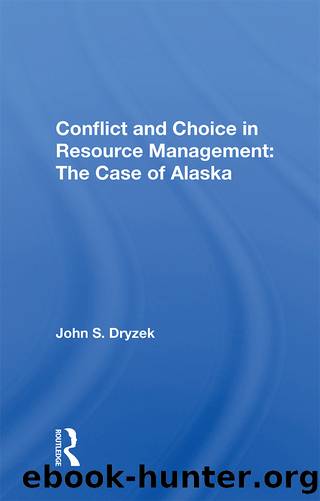Conflict and Choice in Resource Management: The Case of Alaska by John S. Dryzek

Author:John S. Dryzek [Dryzek, John S.]
Language: eng
Format: epub
Tags: Political Science, General
ISBN: 9780429717062
Google: YCqNDwAAQBAJ
Goodreads: 15458522
Publisher: Routledge
Published: 1983-07-20T00:00:00+00:00
An Efficient Future
In chapter 4 it was seen that allocative efficiency as a criterion for public policy is in practice equivalent to the maximization of the contribution of a course of action to the present value of G.N.P. As a concept, efficiency inheres in the welfare economics paradigm. Consequently, any piece of analysis in pursuit of efficiency must work within the confines of that paradigm. Welfare economics tells us that, under conditions of perfect information and the absence of externalities, free competitive markets will in general achieve a utilitarian welfare maximizing optimum; such is the beauty of the invisible hand.1 Could an efficient future for natural resource management in Alaska's coastal and offshore region be secured, then, by letting the free market operate without government intervention? Quite clearly, it could not. There are several reasons why a pure market solution is unattractive. First of all, information as to the extent of oil reserves in any location and the costs and benefits of their production is scarce, and it has public good aspects which impede its generation.2 Second, externality effects are ubiquitous - decisions can affect individuals who have no input into market determined outcomes. Third, any markets that did exist would hardly be competitive. There is monopoly or oligopoly in the effective control of natural resources - few actors have the capability to produce oil. Fourth, many natural resources exhibit "common pool" problems; for example, if an oil reservoir is being exploited by more than one enterprise, each producer has little incentive to deplete the reservoir in a manner conducive to efficiency by maintaining gas pressure in the reservoir or siting wells in the most efficient pattern. Fifth, oil companies as they operate in Alaska do not approximate the atomistic profit maximizing entities of neoclassical microeconomic theory. Rather, they have strategic interests which differ from company to company (see chapter 3).
Given the unattractiveness of a pure market solution, what can governments do to promote the achievement of economic efficiency? Economists see the proper role of government as correcting for market imperfections; to facilitate the outcomes a free market would produce if it were working well. Cost benefit analysis is the appropriate technique for deciding on the proper course of action, as pointed out in chapter 4.3 Unfortunately, cost benefit analysis requires considerable amounts of time and effort for an effective application; moreover, it is applicable only in the comparison of a small number of predetermined and well-defined alternatives. It is therefore inapplicable to policy design (as opposed to policy evaluation). Thus economic analysis in its policy applications normally proceeds in a more speculative and discursive fashion, losing some of the precision of cost benefit analysis.
How fast should oil and gas development proceed? A detailed study of energy alternatives for the United States (or global) economy is obviously beyond the scope of an essay such as this.4 However, as long as energy prices remain high, efficiency dicates that Alaskan oil be developed as an energy source. At what pace, then, should exploitation take place? Two offsetting effects come into play.
Download
This site does not store any files on its server. We only index and link to content provided by other sites. Please contact the content providers to delete copyright contents if any and email us, we'll remove relevant links or contents immediately.
International Integration of the Brazilian Economy by Elias C. Grivoyannis(74996)
The Radium Girls by Kate Moore(11621)
Turbulence by E. J. Noyes(7702)
Nudge - Improving Decisions about Health, Wealth, and Happiness by Thaler Sunstein(7244)
The Black Swan by Nassim Nicholas Taleb(6770)
Rich Dad Poor Dad by Robert T. Kiyosaki(6179)
Pioneering Portfolio Management by David F. Swensen(6081)
Man-made Catastrophes and Risk Information Concealment by Dmitry Chernov & Didier Sornette(5650)
Zero to One by Peter Thiel(5494)
Secrecy World by Jake Bernstein(4389)
Millionaire: The Philanderer, Gambler, and Duelist Who Invented Modern Finance by Janet Gleeson(4099)
The Age of Surveillance Capitalism by Shoshana Zuboff(3989)
Skin in the Game by Nassim Nicholas Taleb(3968)
The Money Culture by Michael Lewis(3849)
Bullshit Jobs by David Graeber(3833)
Skin in the Game: Hidden Asymmetries in Daily Life by Nassim Nicholas Taleb(3724)
The Dhandho Investor by Mohnish Pabrai(3561)
The Wisdom of Finance by Mihir Desai(3526)
Blockchain Basics by Daniel Drescher(3330)
